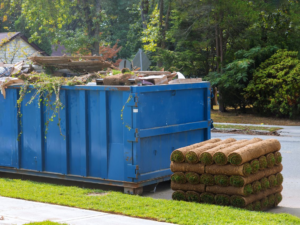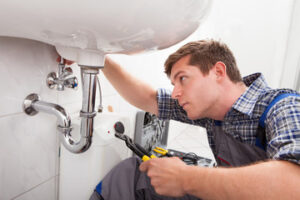Dumpster Rental Maryland is an easy and convenient way to handle your trash disposal needs. Whether you’re a homeowner who is doing some remodeling or a contractor working on a construction site, there is always going to be some junk that needs to go.
Many companies offer flat-rate pricing that includes all costs and fees, including rental periods, taxes, service fees and transportation charges. This saves customers time and money in the long run.

Dumpster rental is a convenient and efficient way to dispose of waste. It allows homeowners and contractors to streamline the cleanup process by eliminating multiple trips to a local landfill or waste disposal site. Dumpsters are available in a variety of sizes to accommodate different waste volumes. However, there are a few important things to keep in mind when renting a dumpster. For example, it is important to check with your local municipality to find out if there are any restrictions on what can and cannot be placed in the dumpster. For instance, some materials may require special disposal, such as paints, chemical cleaners, or motor oil.
The first step in the dumpster rental process is to determine the size of the container you need. This can be done by visiting the website of your chosen dumpster rental company. Alternatively, you can contact the customer service department for assistance. Once you have determined the size of the dumpster, it is time to schedule delivery. The delivery date will depend on your project schedule and the availability of your local waste management facility.
Once your dumpster is delivered, it will be placed on your property and loaded with the waste you have accumulated. The company will then haul the waste to a local landfill or recycling center for proper disposal. The dumpster will be returned after you have finished with it, and the deposit will be refunded. The price of the dumpster rental will depend on the size, location, and disposal method.
When choosing a dumpster rental company, make sure you select one that offers a wide range of options and has competitive prices. Also, be sure to consider additional charges for the use of hazardous waste containers. These charges may include a surcharge for non-hazardous waste or a fee for the disposal of large quantities of waste. Additionally, you should consider the weight limit for the dumpster. Some companies may limit the amount of trash that can be disposed of per month. This can be helpful if you are planning on doing a major cleanup or renovation project in your home.
A dumpster rental is a convenient way to get rid of large amounts of trash. It helps reduce waste disposal and recycling costs, as well as promotes resource efficiency. It also allows businesses to demonstrate their commitment to sustainability. However, it’s important to know what materials can and cannot be placed in a dumpster rental. This will help avoid any penalties or fines.
There are some common items that are not allowed in dumpster rentals, including household paints, chemical cleaners, and automotive fluids. It’s also not recommended to throw hazardous waste in a dumpster. These chemicals are dangerous to the environment and can pose a health hazard to workers.
Most dumpsters are not designed to hold all types of garbage. Some items are better suited for other disposal methods, such as electronic waste or yard waste. Some dumpsters have separate bins for these different kinds of waste. Others have a separate area for wood and other building materials. This can be helpful for contractors who want to separate their waste materials during a project or cleaning out an estate.
Dumpsters are also a great way to dispose of green waste. They can be used to dispose of tree branches, leaves, and other environmental flotsam that may be piled up around your home or office. This is a great way to recycle and protect the environment at the same time.
It is recommended that you rinse out any bottles of liquid before placing them in a recycling dumpster. This will help to remove any food particles and decrease the risk of contamination in the sorting process. It is also a good idea to remove the caps and lids from containers before throwing them in the dumpster. This will help to prevent the caps and lids from slipping through the sorting machines and contaminating the entire batch.
Renting a dumpster can be an efficient and cost-effective waste management solution for residential, commercial, and industrial projects. Many waste management companies provide dumpster rentals for multiple sizes to accommodate varying project needs. They also offer pickup and delivery services for an additional fee.
Dumpster rental allows homeowners and contractors to safely dispose of large amounts of waste. Whether you’re cleaning out your garage, remodeling your home, or working on a construction site, a dumpster can help you get the job done quickly and efficiently. However, it’s important to understand the rules and regulations surrounding dumpster placement so that you can avoid fines and other problems.
There are several things that you cannot place in a dumpster, including household paints, old appliances, chemical cleaners, and motor oil. It’s also important to consult with your dumpster rental company and your municipality to determine what items can and can’t be placed in a dumpster. This will ensure that you don’t end up with a dumpster full of dangerous materials and waste, which could pose a health and safety risk for the people who are loading and unloading it.
The best location for a dumpster is one that is easily accessible. It’s also a good idea to keep it away from driveways and other areas where vehicles might drive over it. This will prevent damage to the tires of the vehicle and protect the driveway or walkway from being damaged. You should also consider the size of the dumpster when choosing a location. If you have a large amount of trash to dispose of, it may be necessary to rent a larger dumpster.
Many municipalities have specific guidelines for where to place a dumpster, how long you can leave it on the street, and other factors that need to be considered. Check with your local building department or city hall to learn more about the specific requirements for dumpster placement in your area.
A dumpster rental is an excellent way to tackle any cleanup or renovation project. It can save you time and money by reducing the number of trips you have to make to a landfill or waste disposal site. And, by following these tips for a successful dumpster rental, you’ll be sure to get the most out of this valuable waste management service.
Dumpsters are a great tool for businesses and homeowners looking to manage waste effectively. However, they also come with their own set of safety risks that can threaten the health and well-being of those who work around them. To avoid these dangers, it’s important to follow certain guidelines when using dumpsters to ensure their safe and effective operation.
One of the first steps in ensuring the safety of those working around dumpsters is choosing a trusted and reliable waste management service. This provider should adhere to safety regulations and be capable of handling the specific types of materials your business generates. They should also provide training to employees on the proper loading and disposal of waste materials to ensure safety.
Another crucial aspect of dumpster safety is ensuring that the container itself is properly loaded and secured. It’s best to load it up evenly, with heavier and bulkier items placed at the bottom and lighter ones on top for stability and safety. Doing so prevents the dumpster from becoming too top-heavy and potentially tipping over during transport, which can cause injuries to drivers and other road users. It’s also a good idea to use proper lifting techniques and secure any loose materials to prevent them from shifting during transportation.
In addition, it’s essential to keep in mind that some items are prohibited from being placed in rented dumpsters, such as electronics, hazardous materials, and medical waste. These items should be disposed of separately through the appropriate channels, as failure to do so can lead to fines and penalties from your dumpster rental company. Additionally, it’s wise to check with your waste management company about the maximum allowable weight limit for your dumpster. Exceeding this amount could result in extra charges for your waste removal service and potential damage to the vehicle it uses to haul the dumpster.
Lastly, it’s important to create a safe working area around dumpsters by clearing debris and removing any obstructions that could cause tripping or falling hazards during the cleanup process. This can help minimize the risk of injury and improve productivity while minimizing the time required to complete the job.


